|
Lights. |
|
|
|
Photogenic
Photogen Powerlight
600 I have two of
this AC operated work horse lights.
The manufacture claims these 600 Watt Second
(Joule) strobes have same output as most 1200 W.S. units. The flash
output power and the modelling light brightness are adjustable
by two slide controls on the back, and can be
moved together to keep modelling light brightness similar to
the flash brightness for the unit. They have a
built in photo sensor to trigger the lamp when another flash
fires, so only one camera sync cord or wireless release is
usually needed STATUS: Active |
|
|
Photogenic Eclipse 60” umbrellas I have two, and are used with the above Powerlight units With
the silver interior surface they reflex almost all the flash
power and provide strong lighting, way more than required for
modern digital cameras and fast lens. STATUS: Active |
 |
|
|
|
Crown Pro VS-201 strobe A lower power AC strobe. I usually have a snoot on it for giving some kick light to hair. STATUS: Active |
|
|
Honeywell 52A modelling slave Strobonar I have had a pair of these lights since the 1960’s.
They still work (2017).
Complete with the accessory kit which provided barn
doors, white, green, red, blue, and dark grey lens in addition
to the clear lens STATUS: Semi-active
|
|
|
Metz 60CT1 "potato masher" This replaced my old Metz 202 flash.
More power =bigger guide number, better auto exposure
control,
and instead of dumping the un-needed energy
during the flash, a thyristor is
used to stop the flow to the flash tube when needed and saves
the energy for the next flash.
Otherwise very similar.
It uses the same batteries as the 202, including the old NICAD
pack which occasionally gets new C cells put it. I also have a Metz 60-40 slave head that attaches to the power
pack and give me a second light source, also fully automatic STATUS: Semi-active |
|
Light
Meters |
|
|
|
Minolta Flashmeter VI This meter reads ambient, flash or the combination.
It works on the flash either corded or just detects
when the flash goes off. It measures incident light with the white dome, replace that with
a disk for reflected light, or use the lens and optical finder
for a spot meter mode. Allow
you to take a number of reading, and specify if those reading
are high light, medium light or low light (shadow) areas. It comes up with the
proper exposure values for the camera.
I still use it with the studio strobes to verify the lighting
ratios of each light, and gives me a quick starting aperture
for the camera as well as balancing the lights.
Since I am using digital bodies, I can review the
result exposure and tweak a little. STATUS: Active |
|
|
Gossen Color Pro 3f colour temp meter This was really much more important in the film era, so it does
not get used very often any more. It reads the colour
temperature of the light and indicates the required correction
filter to bring the colour balance into line with what the
film requires. STATUS: Active |
|
|
Gossen Sixticolor
Colour temp meter The predecessor to the above 3F meter, this one was first
released in 1958. I
got it used, did the same thing as the more modern version
only in an analogue manner.
Also it is nowhere near as sensitive to light as the
new one. Worked
very well in bright light, but for dimmer interior lights, you
had to move right near the source. STATUS: SOLD |
|
|
Gossen Lunasix light meter This was my standard light meter for many years while shooting
wedding. Since
the Hasselblad gear did not have built in light meters.
It could read reflected or incident light by moving
the top covers. Most
likely would work if I could get some mercury batteries for
it. STATUS: Retired to display case |
|
|
Weston Master III British made light meter made 1956 to 1960. This was my upgraded meter as a teenager. It had a bit better performance than my old GE meter. Still works No
batteries needed STATUS: Retired to display case |
|
|
GE DW-68 meter Very simple meter from 1950. This was my first good working meter in high school. It had removable hood that converted the meter to read incident light directly in footcandles. Still working No batteries required
STATUS: Retired to display case |
|
|
Hanimex PR-85 Spot meter Got this one in high school.
It had the long right angle telescope viewer that you
looked through and when on target, press the needle release
button on the rear to take reading.
Unscrew the telescope unit, install the lens cone
like unit and it reads reflected light at about 30 degrees
view. Swap that
for the dome and you have an incident light meter.
Sweet. STATUS: it died |
|
|
Bewi Zoom spot meter This was from the mid 1970’s.
It would take a reading over whatever area you zoomed
the viewfinder to,
So you could take a larger area, or zoom
down to get reading of 1 degree area.
I used this a lot for wedding work, to meter church
windows and other places where I could not walk up and take
reading with the Lunasix meter. When I got the
Minolta flash meter 6, I traded this one in as most of my gear
had built in TTL metering including spot metering, and this
thing took mercury cells. STATUS: SOLD |
|
Tripods,
Monopods and Heads |
|
|
|
Gitzo G1228 Mountaineer carbon tripod One of the very first carbon fibre tripods, I got this back in
about 1995. It is still my favourite tripod.
I have an accessory very short column that will pop
into the top for at ground level shooting.
And I have covered the legs with foam covers usually
used for bicycle handlebars.
Add a carry strip, and the added bubble level to the
column, and your ready to go. I often put about 20
lbs of gear on top with no issue (1dx body, 600mm f4, 2X
converter, gimbal mount and a flash gun., it adds up) STATUS: Active |
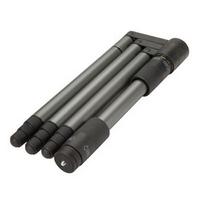 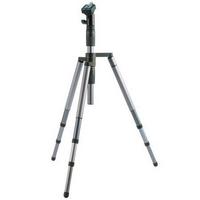 |
Culliman Magic 2 Tripod
I bought this one back in about 1990. All metal, it folds
very flat, taking up about 13.7" x 1.5" and about 2.5
lbs. It can be extended up to 57". The one leg
unscrews, and fits on the bottom of the centre column to make
a monopod. I usually use it with the Sirui K-20X ball
head instead of the one that came with it. I have also
added a metal loop on the bottom of the elevator to let me
attach my bag to bottom for added weight while shooting.
STATUS: Active |
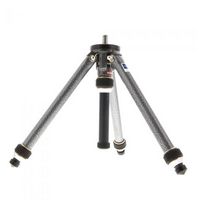 |
Gitzo G0011 Table Top all metal Tripod
I got this one back in about 1996. All metal, it extends
from 7" to 19". The little tripod will take a load of
5.5 lbs. I generally have a small Manfrotto ballhead on
the top (head came from a Manfrotto 331 system for a
monopod). I generally have used this in the past as a
little travel pod, with a full sized SLR camera and L series
wide angle lens on it. Although it has also be very
useful in the studio as a support for a small strobe like the
Honeywell 52A as a low floor light behind the subject to
illuminate the background. STATUS: Active |
|
|
Arca-Swiss-Monoball-B1-Ballhead Still the best ball head. Strong,
good for 90 Lb. load, reasonably light (1.7 lbs), Purchased
this to work with the Gitzo carbon tripod, having tried some
other small ball heads and was unhappy with their performance. Almost all my bodies
and lens have an Arca Swiss quick release plate on them. One of the great features is not only can you set how loose the
ball can be released (small surface knob on face of big
release knob) but it self tightens the more off centre you go,
so it tries to keep from damaging the camera/lens if you
should let go and the camera tries to dump over. STATUS: Active |
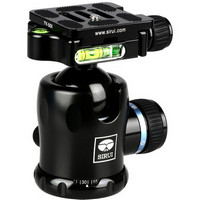 |
Sirui K-20X Ball Head This one is way smaller and lighter (0.9 lbs.) than the
Monoball. It fits nicely on my smaller tripods and is
rated to take up to 55 lbs. Plus it has two
levels. It does have a tension adjustment knob on the
main release knob to restrict how loose the ball can be set,
similar to what the monoball has. But not the self
tightening ball shape STATUS: Active |
|
|
NEST NT-530 carbon fibre gimbal head I mostly use this head with the 600mm F4 lens.
It allows me to follow birds, planes or other wild
life, but has adjustable drag/locking knobs and balance
positioners so I can let go of the camera/lens and it just
stays there. I
also have used it with the 300mm while shooting videos of
aerobatic aircraft. This replace a Wimberley sidekick
that either attached to the Arca
B1 monoball or I had made a special dedicated mount for it. This is a bit
larger, but because it is taller, allows me to shot almost
straight up. STATUS: Active |
|
|
Really Right Stuff lever operated quick release clamp
for AS plates I have a couple of these. One
sits on a monopod, the other is attached were needed.
Very fast on/off the monopod without concern of
camera coming loose. STATUS: Active |
|
|
Gitzo G1560 Aluminum monopod/walking stick A very strong, and light monopod.
Constructed of aircraft grade aluminum.
It is very rugged and light.
I have hiked in many parts of the world and this is
my hiking stick. It has a small ball head on the top, hidden
under a plastic cover. Pull the top off, attach camera, shot
the video or use the telephotos and done. STATUS: Active |
|
Bags
and Cases |
|
|
|
LowePro dryzone 200 backpack A carry on sized backpack that is waterproof, it floats The outer shell is a black re-enforced vinyl like material with a
waterproof zipper. I
can fit a 300mm f2.8, 5D body 7D body, 16/35 f2.8 lens, 70/200
f2.8 lens, two teleconverters, a
GoPro, small point and shoot, and on the outside room for a
small laptop (not in the waterproof area) and other travel
stuff. STATUS: Active |
|
|
LowePro lens trekker 600 Designed to take large lens, I can fit the 600mm f4 lens with a teleconverter and body attached into
the back. Put the
tripod on the outside. If
I am using a small head like the sidekick, then it will fit in
the lower pocket at the rear.
Otherwise the big carbon fiber gimbal head sits in
its own back hung on the back.
A rain resistant cover is attached that can be pulled
over the case in the event of rain STATUS: Active |
|
|
LowePro Stealth report 650 AW An oversized shoulder bag, carries a smaller laptop, space for a
couple of pro bodies and lens.
Stuff can be gotten to through a zip opening in the
top without having to fully open the bag.
I usually use this at event, and smaller shoots. STATUS: Active |
|
|
Kata 3n1-20 sling pack This is a bag that can be used as either a left shoulder sling,
right shoulder sling or with both straps and waist band as a
backpack More than small enough for carry on. I have put: a 1Dx 16/35 f2.8,
plus 7D2 with booster, 16/35 f2.8 lens, 70/200 f2.8 lens, 2x teleconverter GoPro, Garmin GPS, small audio recorder, spare batteries, small
waterproof point and shoot Filters, and a few other odds and ends. About the only change I made was to add a chest strap to keep the
two shoulder straps together when using it as a backpack. STATUS: Active |
|
|
Lowepro Pro Tactic BP 450 AW II
This is the new
travel bag. About as large as you can take as carry on for a
plane. It is
lighter than the dryzone 200, and
has a few good features such as from the top you can access a
body with telephoto attached, from one of the side accesses
you can grab a body with a wide angle, and from the other side
access you can get misc. gear.
Another great design idea was to have the large
opening cover or lid be on the shoulder harness side.
So when wearing the pack, if the main zipper fails,
not much can fall out. It
also takes a mid. sized laptop in the cover.
It includes an all weather cover that can be pulled over the
case to keep rain off. So far it has worked
fine. Takes the street and
field components
STATUS: Active |
 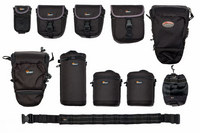 |
LowePro Street and Field system
I have loved this system for decades. There are many various lens tubes and cases for gear. All can be attached to various system belts (either thin or thick), vests and onto their various backpacks. The vest or the strap set can be attached to the large lens trekker 600 to make it into a backpack instead of over the shoulder. The larger lens tubes can be used with a shoulder strap or attached onto a pack, belt or vest.
STATUS: Active |
 |
LowePro lens exchange lens case I have a short one (100) and a long one (200). They fit either on you normal belt or better on a wide belt from LowePro. Quick single pull unzip, take one lens off you camera and land in the open section of the two lens spaces. Take second lens put on camera. Zip case closed. Allows lens changing when you have no place to set stuff down. STATUS: Active |
|
|
|

























